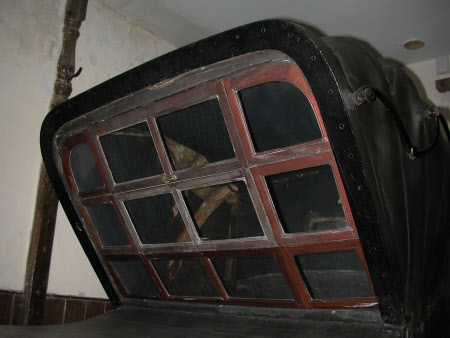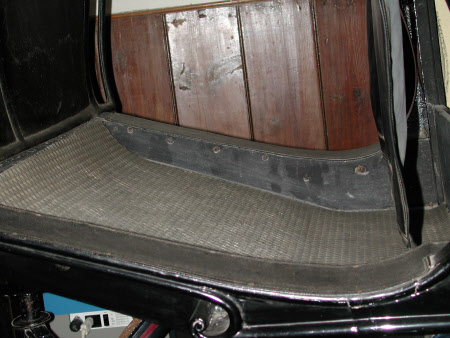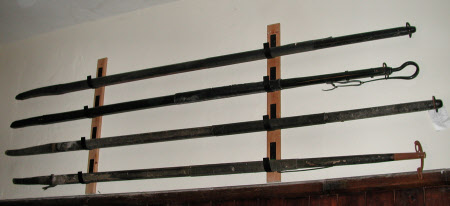Barouche
Turrill and Sons
Category
Carriages & other vehicles
Date
circa 1840
Materials
Glass, Leather, Rubber, Textile, Wood
Measurements
2440 x 1830 mm; 3700 mm (Length)764 kg (Wt)
Order this imageCollection
National Trust Carriage Museum
NT 272886
Summary
Road or Travelling Barouche built for the Marquess of Bute by Turrill and Co circa 1840.
Full description
Step piece barouche with front boot framed to the body and mounted on beautiful scroll carved blocks. Dropped footboard between carved and moulded brackets.Double seat rails to coachman’s seat, which has two seat boards hinged about their front edge, so that the top board can be hinged over and the two boards form a large platform for carrying luggage. The top board cannot now hinge over because it fouls the dashboard. Perhaps this was intended to be fitted only for town driving and removed for travelling. Sword case on back panel. Hind footboard mounted on cross bar that is supported by the cross spring, between unusually long pump handles, and stay to the underside of the body. The steps show that a hind boot must have been bolted to this footboard, but it is missing. In dark green and black livery with red lining. Dark blue interior trim, with rubber driver's footpad. This carriage could be either coachman- or postillion-driven and was used for making long journeys. As on all barouches, only the principal seat at the back of the body is protected by the folding leather head. There is another seat at the front which was only used in fine weather, when the knee flap would be raised to form a seat back. This example has a series of hinged boards, known as a water deck, which can be folded up and strapped onto the knee flap. When they are unfolded they protect the legs of the occupants, who have the additional protection of a screen of small glazed windows. These can be folded together and strapped into the head frame when they are not needed. The coachman’s seat board is actually two boards, and the top one can be hinged over to make a large platform to carry luggage. Like the travelling chariot it has a sword case. This carriage, which is another that was donated by the Marquis of Bute, was built by Turrill of Long Acre, London, who built most of the Bute family carriages. CJN 05.02.09 Doors Doors on two butt hinges with brass T handles. Steps Oval jagged plate steps at doors with folding steps concealed behind hinged iron plates. The nearside plate cannot be opened, and the step mechanism is incomplete on the offside. Circular jagged plate treads on outer roller bolts. Two square jagged plate steps on the nearside of the hind footboard, the lower step is lipped. Windows There is a screen in the head frame consisting of twelve mahogany framed glazed lights made in such a way that it can be folded into the space of two lights, hinged back when not needed and supported by a strap in the top of the head. Rectangular back light. Lamps Lamp brackets bolted to the front wings but lamps missing. External Furniture Brass. CARRIAGE Wheels Twelve and fourteen spoke English pattern wheels with staggered spokes and flat iron tyres. Axles Collinge’s patent axles – straight. Springs Elliptic springs in front, clipped to axle and wheel iron heads. Dennet springs behind – two side springs and one cross spring – with side springs clipped to axle and cross springs bolted to span iron. The front ends of the side springs are bolted to branch scroll irons. Their back ends are connected to the cross spring by cow mouth shackles and robin rings. Fore carriage Close futchell fore carriage with straight beds that have circular pattern fiddle ends. Full wheel plate. Turned splinter bar compassed down beneath the futchells. Pole not seen. Brake No brake. Substantial hook on transom for drag shoe chain, and hook on front end of the nearside side spring to suspend the shoe when not in use. Drag shoe and chain missing. Paint Boot, underside of body, body frame, sword case – black. Body panel – dark turquoise. Wheels and carriage – dark blue with broad red lines on wheels only. This is very inappropriate on a carriage of this character and quality. Leather Leather head, leather covered sword case and leather seat valance. The seat valance is split because there are two seat boards. The dashboard and wings are leather-cloth, and the water deck is covered with leather-cloth. External Trimming Black leather-cloth seat fall and similar trimming on the brackets. Black rubber mat with diamond pattern on front floor and footboard. Internal Trimming The remains of the seriously damaged blue head cloth and the webbing of the principle seat are all that survive of the interior trim.
Provenance
Owned by the Marquess of Bute family. In 1947 the 5th Marquess of Bute donated ten carriages to the National Museum Wales (then Welsh Folk Museum), without any conditions attached to the donation. In 1948, when the Welsh Folk Museum opened two of the carriages were put on display in their coach house, but they could not display the other carriages, which were put into storage. In January 1964 the 6th Marquis of Bute suggested that the carriages in store could be given to the National Trust to help establish the carriage collection at Arlington Court. As the carriages were in the ownership of the NMW they arranged for the unconditional transfer of 8 carriages to Arlington Court.
Makers and roles
Turrill and Sons, carriage builder




